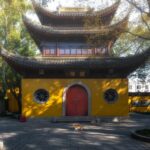The Beita Pagoda stands at a height of 76 meters, with eight sides and nine levels, proudly towering over the Jiangnan region. Originally, one could ascend to enjoy a panoramic view of the entire city, but currently, the scenic area is under renovation and closed to visitors.
Surrounding the pagoda, remnants of the Bao’en Temple, rebuilt during the Ming and Qing dynasties, still stand. The Beita Pagoda is a Chinese pavilion-style Buddhist pagoda, initially constructed during the Three Kingdoms period. It is said to have been built by Sun Quan to express gratitude for his mother’s kindness, hence the name Bao’en Temple Pagoda.

To the east of the pagoda lies the Unsullied Guanyin Hall, commonly referred to as the Nanmu Guanyin Hall, which was first built in the 23rd year of the Shaoxing era during the Southern Song Dynasty. The existing hall was reconstructed during the Wanli period of the Ming Dynasty and is one of the well-preserved Ming Dynasty structures in Suzhou.

South of the Guanyin Hall, a long corridor houses one of the largest giant lacquer carvings in China, known as the ‘Prosperous Era Breeding Chart’ or ‘Gusu Prosperity Chart’, measuring 32 meters in length and 2 meters in height.

Behind the pagoda, there is a rare stone carving from the Yuan Dynasty, the ‘Zhang Shicheng Merit Stele’. To the north of the pagoda are the Ancient Bronze Buddha Hall and the Sutra Pavilion. The Ancient Bronze Buddha Hall once housed a bronze-cast triad of Buddhas and features a hip-gable roof with a hard mountain design, a Guanyin pouch mountain wall, and beam and ridge decorations that exhibit Huizhou architectural style.
Beita Bao’en Temple Pagoda
The Beita Pagoda stands at a height of 76 meters, with eight sides and nine levels, proudly towering[...]









